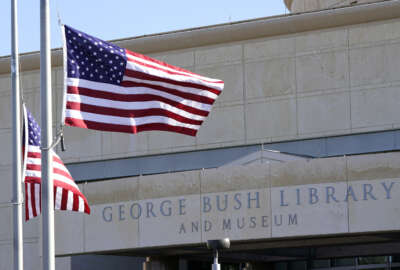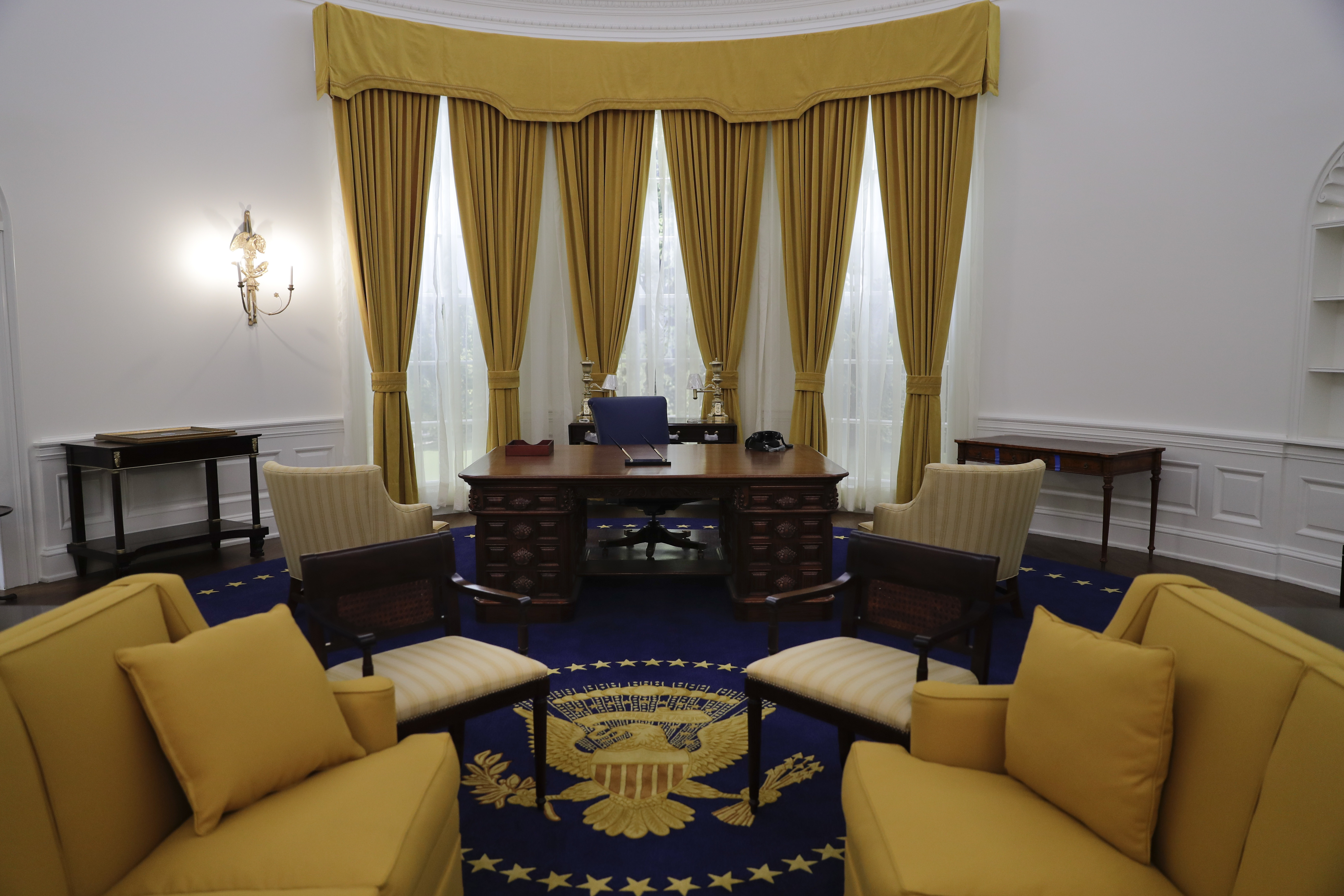A new director for the latest presidential library
Kenvi Phillips was appointed to be the new director of the Barack Obama Presidential Library by the National Archives and Records Administration.
He may still be out politicking, but former President Barack Obama has already established his library. As of this past summer, it has a new director, Kenvi Phillips, who was appointed by the director of the National Archives and Records Administration. She joined the Federal Drive with Tom Temin to discuss.
Interview transcript:
Tom Temin: And I said you’re the new director, but you’re actually the first director, correct?
Kenvi Phillips: Yes I am.
Tom Temin: All right. Well, now former President Obama is still active in life and in politics and in public life and so forth. You were appointed by NARA. I mean, who’s in charge of the library? And I mean, how does that all interplay the fact that you have a living person still out in the world? There’s a library, there’s narrow records. It sounds complicated.
Kenvi Phillips: It’s actually not that complicated. And President Obama is not the only living former president that has a library. And so but we do have a new model in that the Obama Foundation is the owner and steward of the presidential center that is under construction currently in the south side of Chicago. And the National Records Administration is the steward of official records of the Obama administration. And so we are separate but also partnering and working together to preserve this history and promote it and get it out to the American public. So we are two entities, but we are working very closely together.
Tom Temin: Right. So one half of it is concerned with public events and the artwork and the architecture and the other half is concerned with preservation and access to the official records.
Kenvi Phillips: Yes. And the foundation has a concern with kind of the public facing, but also the preservation of the record. And we also have a concern for preservation and presentation to the public. We literally just kind of work together. So there will be public facing programs and access on our end as well as there will be the museum as well as a branch of the Chicago Public Library on the Presidential Center. We also plan to partner and work together on some of those public programs. And many of the items that we have in our holdings will be on display at the presidential center. So it is a new kind of way, I should say, our end, the NARA’s library is the first digital library, presidential library. So one of our main points of access to the public will be through digital access. A great deal of the Obama administration was administered through electronic records, like 95% of his records were born digital. And so we are fully embracing this new digital world that we all find ourselves in and making sure that we can provide access to the American public across the nation and also internet access to international visitors and folks who are interested in the Obama administration.
Tom Temin: Sure. And those records and objects and items that are not digital, where are they now? Are they in a warehouse awaiting housing to be completed building?
Kenvi Phillips: I would say warehouse, but in our temporary site in Hoffman Estates, Illinois, as well as there are some documents that are housed at the National Archives Center in College Park, Maryland.
Tom Temin: Got it.
Kenvi Phillips: Yeah, we have a couple of places.
Tom Temin: Sure. And the digital records are in the cloud somewhere?
Kenvi Phillips: [The digital records are definitely in the cloud and on hard drives, and we are still processing a great deal of his records. There are millions of terabytes of information, of images, of the emails, of other types of electronic communications that are going, I think, at a massive some 300 million pages of material that are electronic. And so we are in the process of going through and making sure that the public has access to it.
Tom Temin: We’re speaking with Dr. Kenvi Phillips. She’s director of the Barack Obama Presidential Library. And is that as a librarian, I assume that’s what you are, and I hope I’m right, that that’s a big change in library science, isn’t it, that crossover to digital because it’s digital and not visual and not tactile, but also in the sheer volume that digital in genders? Fair to say?
Kenvi Phillips: I think it is a shift in that we’re having to learn new ways to engage. And also it’s a shift in that we’re learning to engage with a new type of researcher and a new demographic. I think some of our older presidential libraries and some of our older libraries where you go into a reading room, there’s a certain kind of expectation that while everybody is welcome, that there’s a general researcher that comes, there’s the scholar, there’s the teacher, that’s this, that and the third, and there’s an embrace with now, instead of having to take the time to go in and go to the orientation and physically make yourself present, you can pick up your phone, you can open up your laptop and you can engage with the materials in that way, which is the way that is a shift in I think everybody across libraries are trying to grapple with the best ways to go about making their materials accessible in a way that we haven’t had to in the past. There’s been kind of an onboarding process where now you go right in as soon as you turn your device on, right?
Tom Temin: Right. So there is less of a connection between research and physical presence than there was, for say, the Nixon Library or the libraries earlier than that?
Kenvi Phillips: Yeah, it is. But at the same time, we’re trying to figure out there’s still value in the human being, the library and the reference library and the person who has knowledge of the material that you want to go through and being able to engage with them and being able to ask them questions to figure out how to get to the things that you want to get to when you want to know. And so there’s still great value in that. And so trying to make sure that we can kind of marry that instantaneous access with the kind of process of engaging and making sure you have full understanding of what’s before you.
Tom Temin: And tell us a little bit about yourself. You’ve been at this a few years and you’ve been in several places with that kind of history and library and academic focus. Tell us more.
Kenvi Phillips: Sure. I am a historian by education. I have worked in academic libraries and local government for profit and as well as nonprofit libraries too. Always with a mind towards making sure that we provide access, both in terms of curating wonderful collections that provide a glimpse into American life and history over time into this broader picture as we campaign, as well as making sure we get access to nontraditional researchers. So school-aged children all the way to senior citizens from scholars all the way through to the lay person who is just has a deep interest in or doesn’t have a deep interest and has a newly found interest in some subject or object that you have in your holdings. And so I think that this is a good chapter, a good page in kind of my career and evolution in making sure that we are able to engage with a broad research base and also be able to get some really good information about the presidency, the Obama presidency specifically, and then just the way we engage with the public. So really exciting.
Tom Temin: Yeah. And do the directors of the presidential libraries confer with one another?
Kenvi Phillips: Absolutely. There are 15 about to be 16 presidential libraries online through the National Archives. And so we meet regularly. And while we all have kind of somewhat different set ups, we all have support from our foundations and support from our communities. And most of us have physical spaces that we engage in, museums that the National Archives stewards, we have a new model where again, we’re partnering with our foundation to stewarding the museum and presidential center, but we all meet regularly to talk about what we’re doing, how things are progressing, making sure that we kind of are on the same page. And we do a lot of work together in planning as we’re planning specifically for the 250th anniversary of the nation, how we’re going to engage together and pull together our resources and our constituencies to make sure that we have a great celebration of the nation’s anniversary. And I should say, we also collaborate with other presidential historic sites for our older presidents, prior to Hoover, to engage and have programing and have conversation about what the presidency of this nation is, has and has been over time.
Tom Temin: And of course, Dwight Eisenhower or Harry Truman can’t drop in on their libraries, so far as we know. But have you ever had, say, President Obama or maybe Mrs. Obama drop in and say, ‘Hey Kenvi, make sure you put this picture up in the gallery?’
Kenvi Phillips: No. The Obamas are deeply invested in the work that we’re doing in the library, as well as at the museum and presidential center. But they have allowed us as professionals in libraries and museums and history to be able to do our work. And so they do weigh in and they do contribute their opinion. And also they do contribute in terms of still being part of because we’re still under the Presidential Records Act. And so all of our records are not fully open just yet. So they still weigh in that way. And they also contribute to conversations about where things are going. But they definitely allow the museum and library professionals to do their work and exercise their expertise.
Copyright © 2024 Federal News Network. All rights reserved. This website is not intended for users located within the European Economic Area.
Tom Temin is host of the Federal Drive and has been providing insight on federal technology and management issues for more than 30 years.
Follow @tteminWFED






